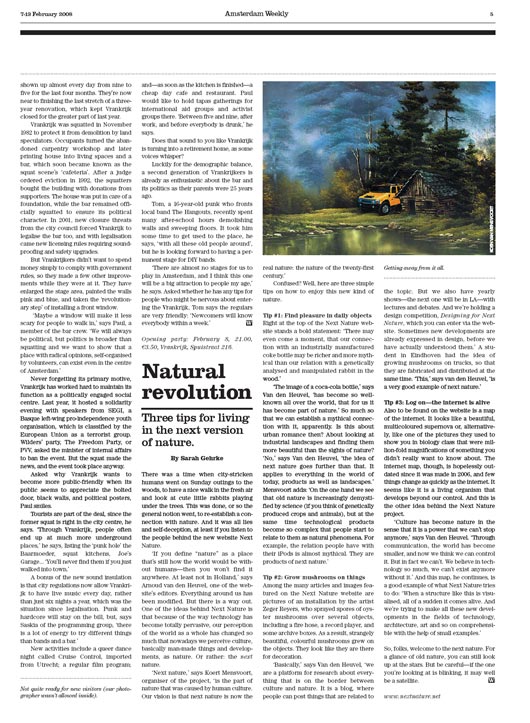
The free cultural paper Amsterdam Weekly discusses the Natural Revolution of and includes tree tips for successful living in the next version of nature. Download PDF (148kb).
NATURAL REVOLUTION
Three tips for living in the next version of nature.
By SARAH GEHRKE
There was a time when city-stricken humans went on Sunday outings to the woods, to have a nice walk in the fresh air and look at cute little rabbits playing under the trees. This was done, or so the general notion went, to re-establish a connection with nature. And it was all lies and self-deception, at least if you listen to the people behind the new website Next Nature.
‘If you define “nature” as a place that’s still how the world would be without humans—then you won’t find it anywhere. At least not in Holland,’ says Arnoud van den Heuvel, one of the website’s editors. Everything around us has been modified. But there is a way out. One of the ideas behind Next Nature is that because of the way technology has become totally pervasive, our perception of the world as a whole has changed so much that nowadays we perceive culture, basically man-made things and developments, as nature. Or rather: the next nature.
‘Next nature,’ says Koert van Mensvoort, organiser of the project, ‘is the part of nature that was caused by human culture. Our vision is that next nature is now the real nature: the nature of the twenty-first century.’
Confused? Well, here are three simple tips on how to enjoy this new kind of nature.
Tip #1: Find pleasure in daily objects
Right at the top of the Next Nature website stands a bold statement: ‘There may even come a moment, that our connection with an industrially manufactured coke bottle may be richer and more mythical than our relation with a genetically analysed and manipulated rabbit in the wood.’
‘The image of a coca-cola bottle,’ says Van den Heuvel, ‘has become so well known all over the world, that for us it has become part of nature.’ So much so that we can establish a mythical connection with it, apparently. Is this about urban romance then? About looking at industrial landscapes and finding them more beautiful than the sights of nature? ‘No,’ says Van den Heuvel, ‘the idea of next nature goes further than that. It applies to everything in the world of today, products as well as landscapes.’ Mensvoort adds: ‘On the one hand we see that old nature is increasingly demystified by science (if you think of genetically produced crops and animals), but at the same time technological products become so complex that people start to relate to them as natural phenomena. For example, the relation people have with their iPods is almost mythical. They are products of next nature.’
Tip #2: Grow mushrooms on things
Among the many articles and images featured on the Next Nature website are pictures of an installation by the artist Zeger Reyers, who sprayed spores of oyster mushrooms over several objects, including a fire hose, a record player, and some archive boxes. As a result, strangely beautiful, colourful mushrooms grew on the objects. They look like they are there for decoration.
‘Basically,’ says Van den Heuvel, ‘we are a platform for research about everything that is on the border between culture and nature. It is a blog, where people can post things that are related to the topic. But we also have yearly shows—the next one will be in LA—with lectures and debates. And we’re holding a design competition, Designing for Next Nature, which you can enter via the website. Sometimes new developments are already expressed in design, before we have actually understood them.’ A student in Eindhoven had the idea of growing mushrooms on trucks, so that they are fabricated and distributed at the same time. ‘This,’ says van den Heuvel, ‘is a very good example of next nature.’
Tip #3: Log on—the internet is alive
Also to be found on the website is a map of the internet. It looks like a beautiful, multicoloured supernova or, alternatively, like one of the pictures they used to show you in biology class that were million- fold magnifications of something you didn’t really want to know about. The internet map, though, is hopelessly outdated since it was made in 2006, and few things change as quickly as the internet. It seems like it is a living organism that develops beyond our control. And this is the other idea behind the Next Nature project.
‘Culture has become nature in the sense that it is a power that we can’t stop anymore,’ says Van den Heuvel. ‘Through communication, the world has become smaller, and now we think we can control it. But in fact we can’t. We believe in technology so much, we can’t exist anymore without it.’ And this map, he continues, is a good example of what Next Nature tries to do: ‘When a structure like this is visualised, all of a sudden it comes alive. And we’re trying to make all these new developments in the fields of technology, architecture, art and so on comprehensible with the help of small examples.’
So, folks, welcome to the next nature. For a glance of old nature, you can still look up at the stars. But be careful—if the one you’re looking at is blinking, it may well be a satellite.
Share your thoughts and join the technology debate!
Be the first to comment